Picking the best English riding boots for yourself is essential. They’ll help you maintain good contact with your horse, constant leg stability and the ability to keep those heels down!
If your boots are too tight, too stiff or too loose you won’t be able to do that effectively. Not only will you lose your ability to ride well, you will also compromise your safety.
The following guide will help you find the best English riding boots for your particular riding discipline.
With proper care, a pair of good-quality English riding boots can last you for years. So it’s important that you choose wisely when searching for your first or next pair of tall boots.
If you’re a seasoned rider and want to jump straight to the ladies tall riding boots, click here!
Still learning? Let’s cover some basics first.
Riding Safety Always Comes First
For riding, the basics you need are:
- Good sole grip so you don’t slip around in the stirrup, and
- A heel so your foot never goes through the stirrup.
The bottom of your boot should be a texture that has some grip.
It can’t be flat and plastic because that’s going to slip right off the stirrup no matter how hard you push your heels down.
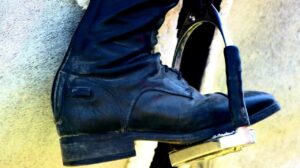
You need something that will stop your foot from sliding all the way forward through the stirrup if your foot slips while you’re riding.
This is where a heel comes in.
You don’t want it to be too high but you also don’t want it to be too short.
Generally, as you probably already know if you’ve done any English riding, you want the the ball of your foot in the stirrup and your weight in your heels as you push those heels down.
Sometimes, however, if your horse spooks or jumps a little too early, or springs into a canter faster than you were expecting, your foot can slip forward. And it’s not safe if your entire foot goes through the stirrup.
This can cause you to get dragged if you were to fall off. With a heel, this won’t be able to happen.
It’s easy to pick a boot that fits well on your feet because it’s not like you haven’t shopped for boots before. Where it gets a bit more ambiguous for riders is around the calves. Your lower legs should not be banging around in your boots.
Think of the boots as feeling like a pair of comfy socks.
They shouldn’t be so tight that you can’t move normally or that you feel a lot of constriction. But they shouldn’t be loose enough to allow any significant movement of your leg inside the boot.
As a rule of thumb, you should be able to fit two fingers comfortably between your boot and the back of your calf, but not three!
Remember, you need to be able to bend your ankles too. If your boot is too stiff and you can’t bend your ankles you’re going to run into issues. Try to do a squat (get your thighs parallel to the ground at least) in your would-be boots to see if they have enough give.
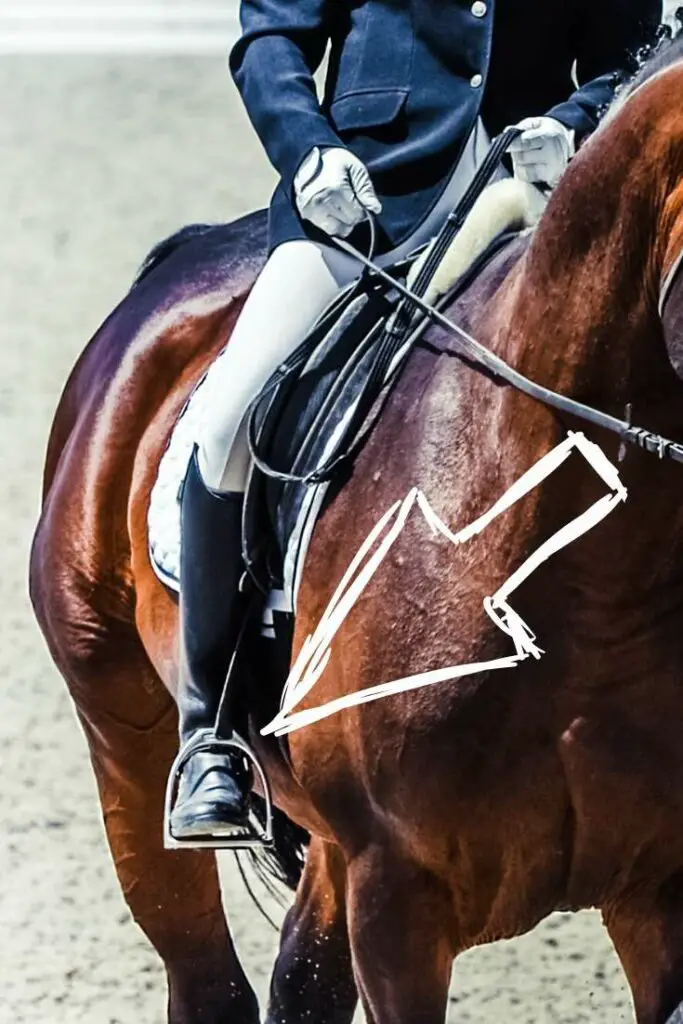
Other Considerations When Choosing A Riding Boot
After making sure your boots are safe (which all authentic tall English riding boots are – they’re made for riding after all!), your choice of boot is going to depend on a few things:
- your riding discipline
- your budget
- the material of the boot
- the style of the boot
Within your riding discipline I would also include things like how often you’re riding.
Let’s say you’re riding once a week during lessons. In that case you’ll probably need one pair of simple paddock boots that you can pair up with half-chaps. Or you can get some field boots.
As another example, if you’re hoping to compete in dressage, you’re 100% going to need a pair of dress boots.
I would still suggest getting a second pair of paddock or field boots that you can work around the barn in and even train in. I’m biased though, because I love short boots to ride in when they’re paired with half chaps. (Traditionally, short boots are only for field work.)
You want to make sure that you ride in whatever boots you’re planning to compete in on a regular basis to get the feel of them. If they’re stiffer boots, you’ll also need to break them in.
ZIPPER VS. PULL-ONS
From paddock boots to the various types of high boots, some boots will have zippers while others won’t. It is really a matter of preference which you are going to get. Generally having no zipper is considered better for competition because it looks better, especially if the zipper is clearly visible.
You definitely should not have any type of visible zipper at higher level competitions. However, some dress boots will have them concealed. They’ll be the same color as the boot and on the inside of the leg.
Pull-on boots generally have loops inside them on the sides that you can pull on with little hooks. Personally I find this super annoying and hate getting these types of boots on and off.
I would buy zippered boots any day but I do have a pair of pull-on boots I used to compete in.
Overall, this comes down to a matter of preference! Just remember, you might not be able to get pull on boots off on your own, at least the first couple of times.
LEATHER VS. SYNTHETIC VS. RUBBER
Generally riding boots are made of leather. The type of leather depends on the type of boot. I find that the stiffer and shinier the leather, the more expensive the boot.
But you will find some boots that are made from rubber.
I hate rubber boots. Even when it’s raining I don’t like them. They don’t give at all over time, they aren’t comfortable, and they they can pinch and hurt.
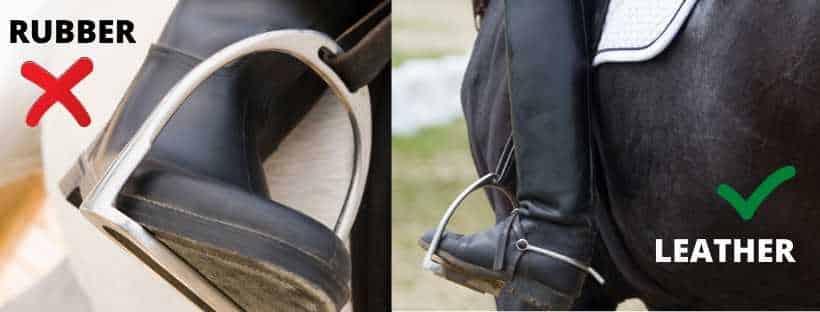
The up side of rubber boots is that they can be easier to maintain than leather. They’re also a fraction of the price of leather boots.
The Different Types of English Boots
We’re not going to go too far in depth into all the different types of English boots here. But if you’re curious about all the types of English riding boots (as well as Western boots) you can check out our Ultimate Guide to Horseback Riding Boots:
Suffice it to say that there are tall English boots and short English boots.
Tall boots are more of the classic competition boots so that what we’re going to focus on for the rest of the post. Here’s a “short” little overview of short boots (I’m so funny! Sorryl sarcasm is so hard to convey in blog posts ? ) :
Paddock Boots (Short Boots) Are Ankle Height, Comfortable & Traditionally Used for Barn/Field Work
Paddock boots are around ankle height, making them a classic short boot.
They are very comfortable, relatively cheap and the easiest to get on and off. If you get a good quality pair, they are super resilient to grit and dirt, water damage, and wear and tear.
These are my actually favourite to ride in because they’re convenient to wear around the barn and they last forever. Then when I’m riding, I just throw on a pair of half-chaps to get better contact with my horse.
Of course you can’t do this for higher level competition but for casual riding I find it’s the best.
The reason these are so comfortable is because they generally have a lot of give and because you can wear them alone or paired with half-chaps – they have the best ankle give. This will allow you to have the best mobility while riding and make it super easy to get your heel down.
I would 100% recommend these (or field boots – which I’ll get to in a second) for riders that are just starting.
Click for our recommendation of short boots >>> Ariat paddock boots:
A Breakdown of Tall English Riding Boots:
We browse the internet looking for the best of the best of everything horse-related so we can share these things with you. When you buy through links on our site, we may earn an affiliate commission.
There are three main subcategories of tall riding boots. They are:
The Field Boot
These boots were originally worn by “field grade” officers in the cavalry — thus their name.
Field boots are tall with laces and tend to scrunch over time
Field boots are easy to recognize because they feature a lace system on their lower front half that provides riders with extra room around their ankles.
Because of this extra room, these boots are more comfortable. They are better than dress boots, for example, for disciplines that require a rider to use a shorter stirrup length and/or to flex their heels down deeply, such as show jumping.
Field boots have a contoured fit through the ankle and are usually crafted from a soft, supple leather for more flexibility.
In addition to show jumping, field boots are a popular choice for many other riding disciplines, including hunter and equitation classes and for the jumping phase of an eventing competition. You can even compete in field boots at lower level dressage competitions.
Two brands of field boots that are especially popular with riders are Ariat — which has been in business since 1993 — and Dublin, which was established in 1980.
If you’re looking for a durable and attractive field boot, you may want to consider the Ariat Heritage Contour Field Zip Tall Riding Boot, which is available for both men and women:

Field boots are also fairly comfortable and they also have a nice grungy look that’s developed over time from the leather scrunching. They are acceptable in competition at lower levels but they don’t usually have the shine or the stiffness that dress boots and dressage boots do.
This makes them comfortable and allows them to wear in quick and to give a lot around the ankles. But it makes them unacceptable for dressage and eventing competitions and higher level jumping shows.
I would say these and paddock boots + half-chaps are fairly similar in terms of comfort. Field boots without a zipper can be slightly more annoying to get on but that’s about it.
Mostly the choice between them would be a matter of preference.
The Dress Boot
Like field boots, dress boots are fitted close to the leg.
Dress boots are tall without laces and hold shape.
The main difference between the two is that dress boots do not have laces, which gives them a cleaner — and some would say more elegant — appearance.
Dress boots also tend to be slightly stiffer than field boots. Because they are less flexible, dress boots are not typically used for disciplines — such as show jumping — that require a shorter stirrup and a more flexed heel. Instead, you’re more likely to find riders wearing dress boots while competing in the hunter division or for lower level dressage tests.
If you’re searching for a good dress boot, check out the ones being offered by Dublin and TuffRider.
Dublin, which bills itself as an “authentic equestrian brand” that was created by riders for riders, offers its Galtymore Dress Boot, which is crafted from premium European leather and features a high-cut Spanish top.
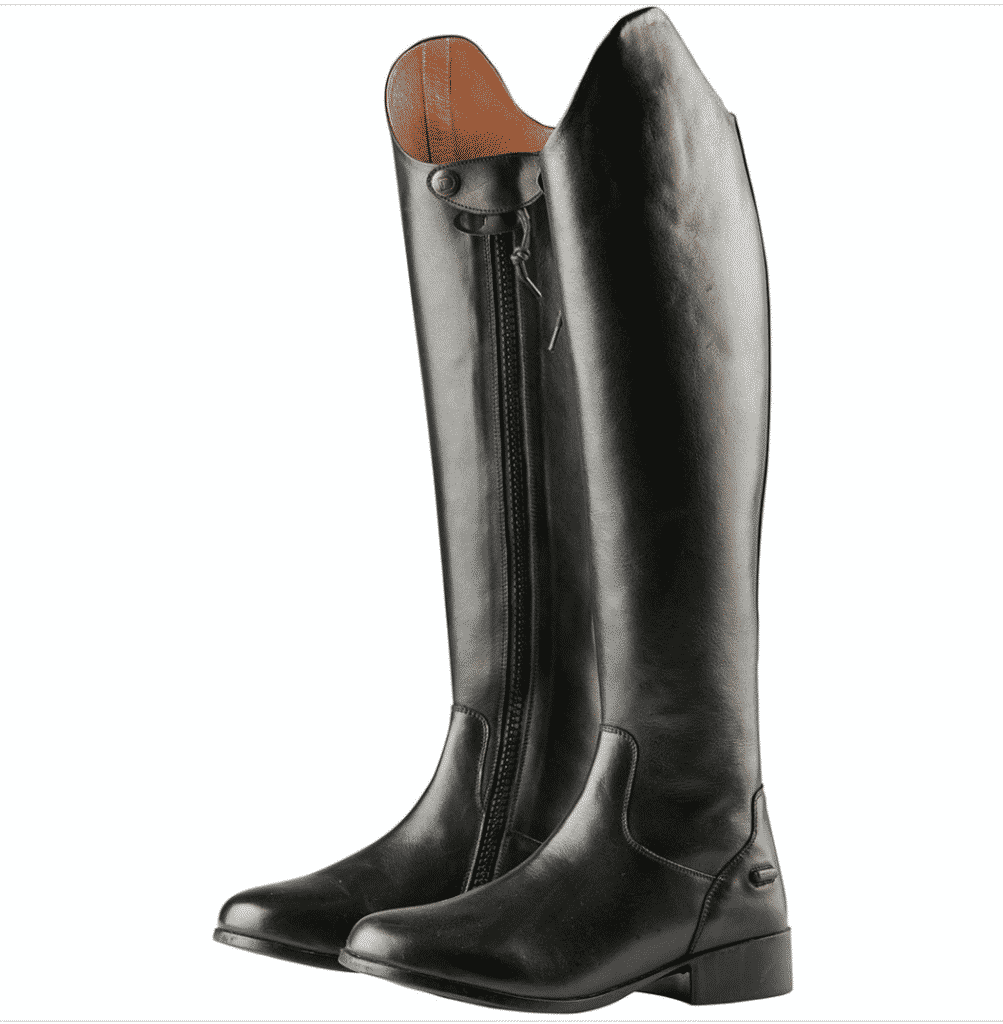
Male riders may want to look at TuffRider’s Baroque Zip Dress Boots, which boasts a zipper for easy on and easy off.
You’ll need dress boots if you’re competing at a higher level in anything from eventing to dressage to hunter/jumper. Nice leather dress boots are going to be more expensive that your general paddock boot or field boot. However, dress boots are less stiff and less expensive than going the full mile to dressage boots.
Dress boots are generally acceptable for any type of English competition. But if you are passionate about dressage, I would invest in a dressage boot because your appearance is very important! And dressage boots are the fanciest you can get.

Dressage boots are tall, very stiff and made for competition.
These are the stiffest, most expensive and most pristine looking of all the boots. You can’t get much fancier than this. I would not invest in a dressage boot unless you are a passionate dressage rider and you know you’ll be competing regularly in the higher levels.
Know with these boots that they take a lot of breaking in and even then, they’ll never have the give of a field boot or even a dress boot. It takes more strength and skill to ride well in dressage boots.
Also they’re just not that comfortable — but I can’t deny they look spiffy.
Spanish Cut or Topline
The ‘Spanish Cut’ is a design element that can be found on both field and dress boots.
With a Spanish topline, the boot will curve upward and be taller on the outside of the knee than on the inside. To onlookers, this design gives the boot a longer, more stylish appearance than it would if it had a standard straight-across topline.
Many different brands offer the Spanish Cut on their boots, including Tredstep Ireland, which was established in 1993. This brand’s Donatello III Dress Boot, for example, features a relaxed Spanish topline.
One of the advantages of a Spanish Cut is that even after the leather has softened and started to drop, your boots will continue to look like they are the appropriate length on your legs.
The Hunt Boot
Hunt boots look very similar to dress boots but have a cuff of leather around the top. Traditionally, this cuff would be crafted of a patent black leather for women and a mahogany-toned leather for male riders.
Hunt boots are only worn for formal fox hunting events, and not, for example, during cub hunting season.
In addition, riders should only wear hunt boots if they have been awarded their hunt colors.
Because the consumer base and demand for hunt boots is very small, you will typically need to custom order them from companies such as All American Boot Manufacturing, which is located in California.
Another company that offers custom-made hunt boots is Der Dau. Established 50 years ago, this New York City company offers several variations of hunt boots, including a traditional Master’s hunt boot with a tan cuff.
Secrets to Picking the Right Tall English Riding Boots…
Secret # 1 (THE FIT)
You need the boot to fit extremely well. Because I guarantee you, it doesn’t matter how pretty it looks or how perfect everything else is, if there’s that one part on the calf that’s too tight, it’s just not going to work.
After hours riding and using your legs, that part that’s tight is going to be all you can think about. It’s going to make your calves sore for the rest of the day.
Also think about what climates you’re riding in. If you’re somewhere super hot all the time then try on your boots in hot weather, with thin socks.
If you know you’re going to be riding in colder weather, then make sure your boots fit with thicker socks.
I used to ride all the time in Canada where it was hot in the summer and freezing in the winter. So I usually wore my paddock boots in the winter because they were a bit looser and I could get thick ankle socks underneath. Then I’d put my half-chaps on overtip that were thicker and made of a warmer fabric.
During the summer during heavier training I wore my dress boots.
Secret # 2 (STIFFNESS & HEIGHT)
Dress boots and dressage boots are extremely stiff, especially dressage boots. These are not going to have any give or scrunch around the ankles or around the top. So you need to make sure that the height is perfect.
As a test, you want to be able to do a squat (that means getting your thighs at least parallel to the ground!) without any pain or pinching. Remember, you need to mount your horse and that won’t be fun if the top of your boot is stabbing into the bottom of your thigh.
With a field boot, on the other hand, it’s okay if its a little high. These types of boots have softer leather that will scrunch both around the ankle and at the top as they wear. This will make the boots lose some height and will also make them softer against your skin so there’s no pinching or stabbing.
Secret # 3 (PRICE)
I would actually recommend buying your boots online. This will save you a lot of money, especially if you can find them used.
Another bonus of buying them used – especially in the case of dress or dressage boots – is that they’ll already be somewhat worked in which saves you those aches and pains of fighting the boot to get your heel down.
Make sure though that the previous owner has taken good care of the boots before you’ve bought them. They should still be shiny without any cracks or obvious defects. You can usually find these on Amazon.
What I would do first is go to my local tack store, try on the boots that I’m interested in until I find exactly the kind that I like and my size. Then I’d go online and try and find a used pair as close as possible on Amazon.
After you’ve picked the right ones, make sure you maintain your boots well! That means keep them clean, dry and the leather hydrated.
Our Tall Boot Gallery – Choose From Our Favourites:
I hope this was helpful for picking the picking the best English riding boots!
Please feel free to comment below with any questions.
Happy riding 🙂
Liked this post? Why not pin it!


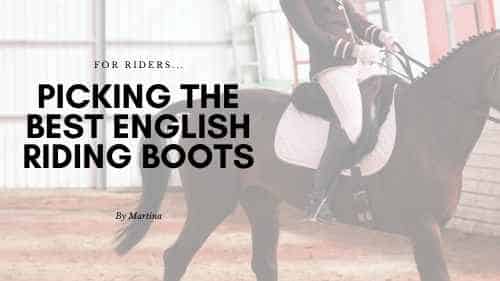
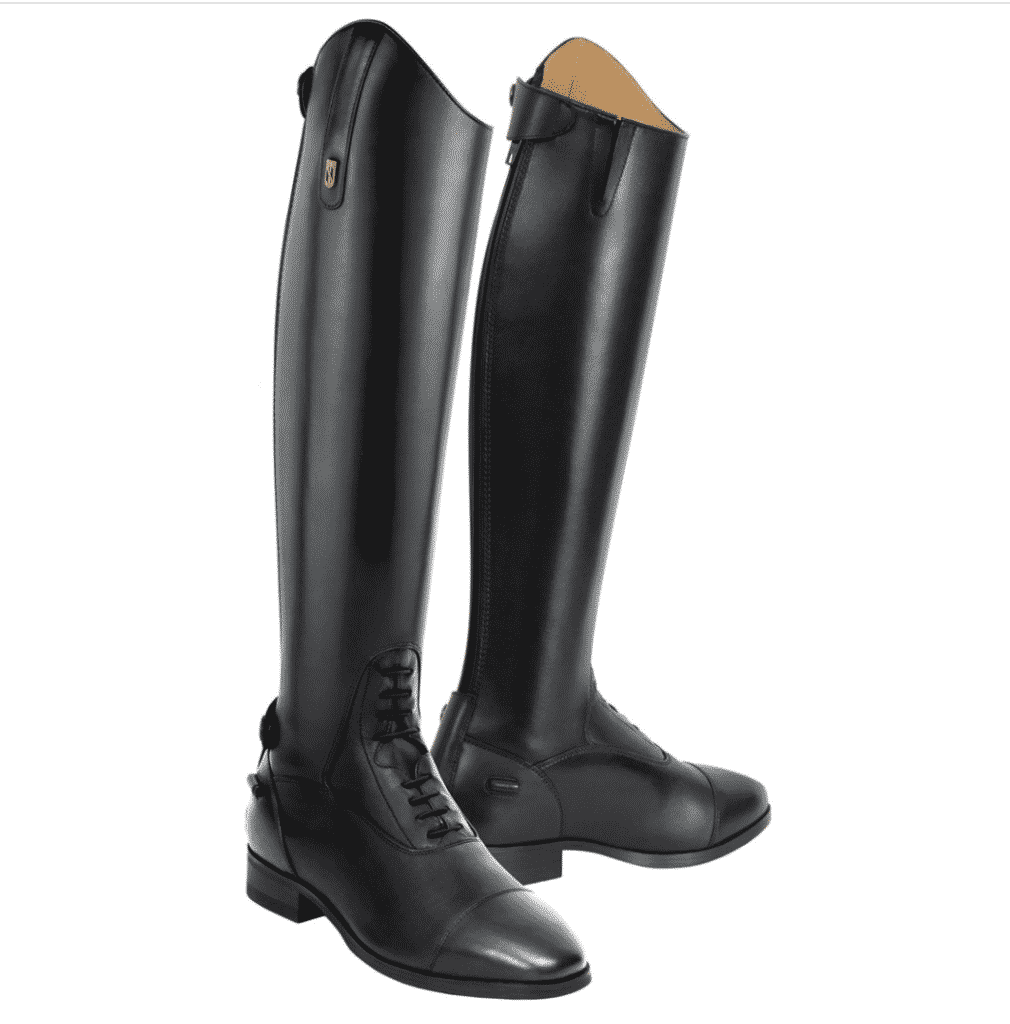


There is not much information over horse riding shoes on internet but I find you have very insight knowledge over the subject. Your website will be very useful for the audience who are engaged in horse riding. I have plans to visit again to see your new posts as well. Keep up the great writing!
Hey Arshad!
Thank you for your positive feedback. I definitely agree with you that there isn’t enough information on the internet about equestrianism. I’m hoping that I can put some information together for anyone who is interested. Also when I was buying my riding equipment, I would just depend on the Amazon reviews or try and sort out what I thought looked the best at the tack store.
Tack stores are very intimidating when you’re young and have no idea what you’re looking for. But luckily, I’ve learned a great deal since then and hopefully I can save others the same hassle!
I hope you’ve learned something new about choosing riding boots!
Cheers,
Martina
Great information on horseback riding boots. I really didn’t know that there was so much that you need to consider when purchasing boots for horseback riding. I have a good friend who is a barrel racer and she had all that gear. I purchased a pair so I could ride with her, but they were the most uncomfortable boots ever. Guess I did not get the right pair.
Hi there!
For barrel racing, your friend probably went with cowboy boots. These are a little bit different to pick out than English riding boots as they don’t need to be quite as fitted.
If you’re interested, you can always read more here about the differences between Western and English riding gear!
But definitely, boots should be comfortable either way like Ariat paddock boots, which personally I think every woman should own if they are even considering riding.
Definitely be sure to dig a little deeper next time before you purchase a pair. Or use the tip I mentioned of trying it out in store and then ordering it cheaper online! 🙂
Cheers,
Martina